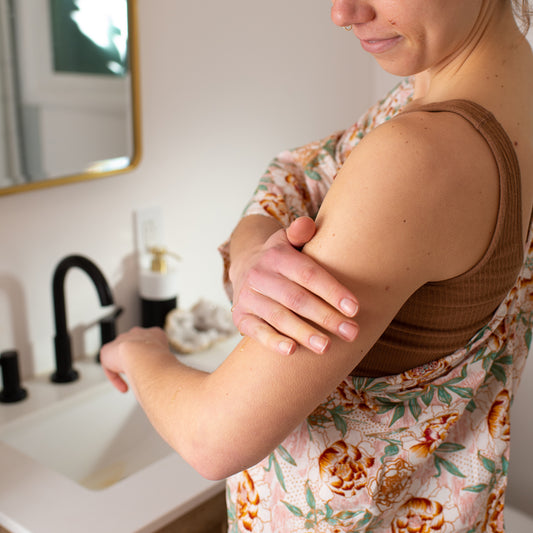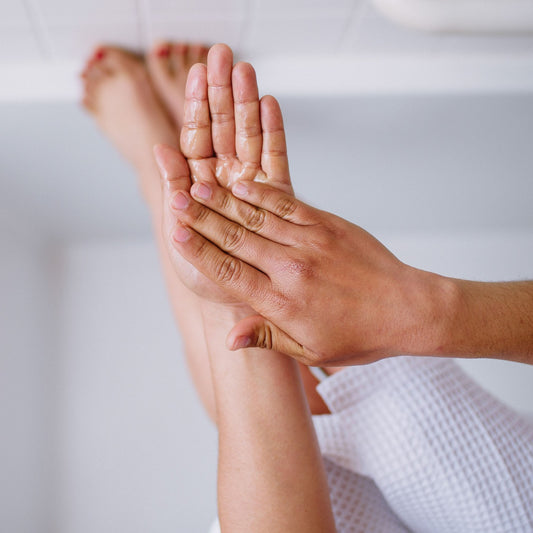Abhyanga, or self-oil massage, has many health benefits. Overall it protects and nourishes the skin, but it has a bonus effect as the oil absorbs into our deepest tissues to keep them supple, strong, and toned, and enhances their quality. In addition, abhyanga touches on the marma points (kind of like acupuncture points) to open up channels and restore proper flow. Abhyanga increases our longevity, strengthens our immunity, promotes peace of mind and calm, and reduces stress! Plus, it just feels so darn good!
Before getting started, watch this lovely demo on how to do the massage part. Now you're ready to walk through how to do an abhyanga and avoid an oily mess.
Before You Begin, Here's What You'll Need
- The oil. Daily Massage Oil is great for all doshas. Or, if you know your current state of balance, you can use the appropriate oil for your dosha: either Vata, Pitta, or Kapha Massage Oil.
- 1 small plastic bottle. Think plastic travel shampoo bottle.
- 1 bath towel you don't care about, dark colors are best so you don't see oil stains.
Now You're Ready to Do the Massage
- Heat up your oil by pouring enough oil to fill your bottle into a small pot on the stove and set heat to LOW. Test the oil with your finger every 30 seconds until it's warm and silky to the touch. Immediately remove from heat and pour into the bottle. If you let oil sit in the pan, the pan will continue to heat it and it can get too hot very fast. You don't want to burn the skin!
- Take your happy warm oil bottle and head back to the bathroom.
- Steam up the bathroom by running a hot shower for a minute or so (or until the room is steamy), keeping the door closed.
- Sit on the toilet seat or a stool with the dark towel you don't care about under your feet. Breathe in the steam.
- Apply the oil by squeezing some into your hand. The oil will help your hands slide nicely on the skin, but not be so slippery that they lose their grip. Apply oil as needed, using long strokes on the bones—with the strokes always going toward the heart—and clockwise circles around the joints.
- Starting with the feet and legs, begin to apply the oil. Once you've finished the feet, stand on your towel. Don't forget your booty and hips. Next, move to your torso (massaging your back the best you can). Remember, your strokes move towards your heart. Next, hands, wrists, arms, and shoulders. Don't forget your face and neck, too.
- If time allows, remain seated for about 10 minutes for a short meditation while breathing in the steam and letting the oil soak in to your skin.
- Turn on a nice warm shower (not hot, hot water is drying) and wash off the oil with a washcloth. (Please note that if you're still oily after your shower, the oil can transfer onto your clothes—and you don't want that! If necessary, use a little soap in the shower.)
- Dry off with “the towel” and toss it in the wash when done. A good laundry detergent will help remove the oil.
- Use some of your kitchen dishwashing liquid to clean out the tub (which can become very slippery after an abhyanga). For safety's sake, make sure you do this every time you give yourself an oil massage!
Yessss. Your body and mind will feel relaxed and your skin like a baby's bum! You'll feel fully restored. This practice will set the tone for the entire day and is especially beneficial if you are ultra-busy! Taking the time to nourish yourself first will allow you to show up and serve the people you care about each day.
Practice abhyanga daily,* weekly, or as needed.
*Vatas-types need abhyanga any time. Pittas-types, not as much in summer. Kapha-types are already oily so use less oil and more vigorous pressure with faster strokes to create heat and release stagnation in the tissues.














